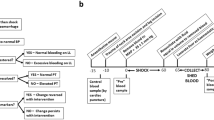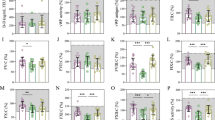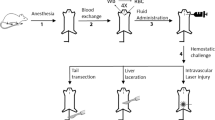Key Points
-
International normalized ratio values in liver disease might be falsely elevated, thus caution should be taken when using this value to consider fresh frozen plasma repletion
-
Cryoprecipitate should be used in the setting of fibrinogen deficiency for proper clot formation
-
Platelet transfusion to at least 50,000/dL can result in adequate thrombin production in the setting of liver disease
-
In cirrhosis patients with chronic inflammation, hyperfibrinolysis can be present and can be treated with antifibrinolytics to promote clot stabilization
-
The knowledge of the coagulation profile for cirrhosis patients is rapidly evolving, future studies might provide further insight into other procoagulant therapies
Abstract
The complex nature of haemostasis in patients with liver disease can result in bleeding and/or thrombosis. These opposing outcomes, which have multiple contributing factors, can pose diagnostic and therapeutic dilemmas for physicians. With the high rate of haemorrhagic complications in patients with cirrhosis, we examine the various procoagulants available for use in this population. In this Review, we describe the clinical and current rationale for using each of the currently available procoagulants—vitamin K, fresh frozen plasma (FFP), cryoprecipitate, platelets, recombinant factor VIIa (rFVIIa), antifibrinolytics, prothrombin concentrate complexes (PCC), desmopressin and red blood cells. By examining the evidence and use of these agents in liver disease, we provide a framework for targeted, goal-directed therapy with procoagulants.
This is a preview of subscription content, access via your institution
Access options
Subscribe to this journal
Receive 12 print issues and online access
$209.00 per year
only $17.42 per issue
Buy this article
- Purchase on Springer Link
- Instant access to full article PDF
Prices may be subject to local taxes which are calculated during checkout


Similar content being viewed by others
References
Tripodi, A. & Mannucci, P. M. The coagulopathy of chronic liver disease. N. Engl. J. Med. 365, 147–156 (2011).
Northup, P. G. et al. Coagulopathy does not fully protect hospitalized cirrhosis patients from peripheral venous thromboembolism. Am. J. Gastroenterol. 101, 1524–1528 (2006).
Shah, N. L., Northup, P. G. & Caldwell, S. H. A clinical survey of bleeding, thrombosis and blood product use in decompensated cirrhosis patients. Ann. Hepatol. 11, 686–690 (2012).
Giannini, E. G. et al. Incidence of bleeding following invasive procedures in patients with thrombocytopenia and advanced liver disease. Clin. Gastroenterol. Hepatol. 8, 899–902 (2010).
Furie, B. & Furie, B. C. Molecular basis of vitamin K-dependent gamma-carboxylation. Blood 75, 1753–1762 (1990).
Iber, F. L. et al. Vitamin K deficiency in chronic alcoholic males. Alcohol Clin. Exp. Res. 10, 679–681 (1986).
Saja, M. F. et al. The coagulopathy of liver disease: does vitamin K help? Blood Coagul. Fibrinolysis 24, 10–17 (2013).
Blanchard, R. A. et al. Acquired vitamin K-dependent carboxylation deficiency in liver disease. N. Engl. J. Med. 305, 242–248 (1981).
Choi, J. Y. et al. Diagnostic value of AFP-L3 and PIVKA-II in hepatocellular carcinoma according to total-AFP. World J. Gastroenterol. 19, 339–346 (2013).
Pereira, S. P. et al. Pharmacokinetics and efficacy of oral versus intravenous mixed-micellar phylloquinone (vitamin K1) in severe acute liver disease. J. Hepatol. 42, 365–370 (2005).
O'Shaughnessy, D. F. et al. Guidelines for the use of fresh-frozen plasma, cryoprecipitate and cryosupernatant. Br. J. Haematol. 126, 11–28 (2004).
Dirckx, J. H. Armand J. Quick: pioneer and prophet of coagulation research. Ann. Intern. Med. 92, 553–558 (1980).
Trotter, J. F. et al. Changes in international normalized ratio (INR) and model for endstage liver disease (MELD) based on selection of clinical laboratory. Am. J. Transplant. 7, 1624–1628 (2007).
Lisman, T. et al. Interlaboratory variability in assessment of the model of end-stage liver disease score. Liver Int. 28, 1344–1351 (2008).
Stravitz, R. T. Potential applications of thromboelastography in patients with acute and chronic liver disease. Gastroenterol. Hepatol. (NY) 8, 513–520 (2012).
Youssef, W. I. et al. Role of fresh frozen plasma infusion in correction of coagulopathy of chronic liver disease: a dual phase study. Am. J. Gastroenterol. 98, 1391–1394 (2003).
Zimmon, D. S. & Kessler, R. E. The portal pressure-blood volume relationship in cirrhosis. Gut. 15, 99–101 (1974).
Moller, S., Bendtsen, F. & Henriksen, J. H. Effect of volume expansion on systemic hemodynamics and central and arterial blood volume in cirrhosis. Gastroenterology 109, 1917–1925 (1995).
Palascak, J. E. & Martinez, J. Dysfibrinogenemia associated with liver disease. J. Clin. Invest. 60, 89–95 (1977).
Boks, A. L. et al. Hemostasis and fibrinolysis in severe liver failure and their relation to hemorrhage. Hepatology 6, 79–86 (1986).
Northup, P. G. & Caldwell, S. H. Coagulation in liver disease: a guide for the clinician. Clin. Gastroenterol. Hepatol. 11, 1064–1074 (2013).
Giannini, E. G. & Savarino, V. Thrombocytopenia in liver disease. Curr. Opin. Hematol. 15, 473–480 (2008).
Lisman, T. et al. Elevated levels of von Willebrand Factor in cirrhosis support platelet adhesion despite reduced functional capacity. Hepatology 44, 53–61 (2006).
Feys, H. B. et al. ADAMTS13 activity to antigen ratio in physiological and pathological conditions associated with an increased risk of thrombosis. Br. J. Haematol. 138, 534–540 (2007).
Ferro, D. et al. High plasma levels of von Willebrand factor as a marker of endothelial perturbation in cirrhosis: relationship to endotoxemia. Hepatology 23, 1377–1383 (1996).
Argo, C. K. & Balogun, R. A. Blood products, volume control, and renal support in the coagulopathy of liver disease. Clin. Liver Dis. 13, 73–85 (2009).
Boccardo, P., Remuzzi, G. & Galbusera, M. Platelet dysfunction in renal failure. Semin. Thromb. Hemost. 30, 579–589 (2004).
Tripodi, A. et al. Thrombin generation in patients with cirrhosis: the role of platelets. Hepatology 44, 440–445 (2006).
Hedner, U. et al. Successful use of recombinant factor VIIa in patient with severe haemophilia A during synovectomy. Lancet 332, 1193 (1988).
Bernstein, D. E. et al. Recombinant factor VIIa corrects prothrombin time in cirrhotic patients: a preliminary study. Gastroenterology 113, 1930–1937 (1997).
Bosch, J. et al. Recombinant factor VIIa for upper gastrointestinal bleeding in patients with cirrhosis: a randomized, double-blind trial. Gastroenterology 127, 1123–1130 (2004).
Bosch, J. et al. Recombinant factor VIIa for variceal bleeding in patients with advanced cirrhosis: A randomized, controlled trial. Hepatology 47, 1604–1614 (2008).
Romero-Castro, R. et al. Recombinant-activated factor VII as hemostatic therapy in eight cases of severe hemorrhage from esophageal varices. Clin. Gastroenterol. Hepatol. 2, 78–84 (2004).
Sartori, M. T. et al. Effect of recombinant activated factor VII in critical bleeding: clinical experience of a single center. Clin. Appl. Thromb. Hemost. 15, 628–635 (2009).
Meadows, H. B. et al. The use of activated recombinant factor VII in a patient with fulminant hepatic failure requiring placement of an intracranial pressure monitor. Ann. Pharmacother. 45, e60 (2011).
Shami, V. M. et al. Recombinant activated factor VII for coagulopathy in fulminant hepatic failure compared with conventional therapy. Liver Transpl. 9, 138–143 (2003).
Stravitz, R. T. et al. Minimal effects of acute liver injury/acute liver failure on hemostasis as assessed by thromboelastography. J. Hepatol. 56, 129–136 (2012).
Caldwell, S. H., Chang, C. & Macik, B. G. Recombinant activated factor VII (rFVIIa) as a hemostatic agent in liver disease: a break from convention in need of controlled trials. Hepatology 39, 592–598 (2004).
Violi, F. & Ferro, D. Clotting activation and hyperfibrinolysis in cirrhosis: implication for bleeding and thrombosis. Semin. Thromb. Hemost. 39, 426–433 (2013).
Caldwell, S. H. et al. Coagulation disorders and hemostasis in liver disease: pathophysiology and critical assessment of current management. Hepatology 44, 1039–1046 (2006).
Colucci, M. et al. Deficiency of thrombin activatable fibrinolysis inhibitor in cirrhosis is associated with increased plasma fibrinolysis. Hepatology 38, 230–237 (2003).
Lisman, T. et al. Thrombin-activatable fibrinolysis inhibitor deficiency in cirrhosis is not associated with increased plasma fibrinolysis. Gastroenterology 121, 131–139 (2001).
Agarwal, S., Joyner, K. A. Jr, & Swaim, M. W. Ascites fluid as a possible origin for hyperfibrinolysis in advanced liver disease. Am. J. Gastroenterol. 95, 3218–3224 (2000).
Fergusson, D. A. et al. A comparison of aprotinin and lysine analogues in high-risk cardiac surgery. N. Engl. J. Med. 358, 2319–2331 (2008).
Gunawan, B. & Runyon, B. The efficacy and safety of epsilon-aminocaproic acid treatment in patients with cirrhosis and hyperfibrinolysis. Aliment. Pharmacol. Ther. 23, 115–120 (2006).
Howell, N. et al. Putting the record straight on aprotinin as safe and effective: results from a mixed treatment meta-analysis of trials of aprotinin. J. Thorac. Cardiovasc. Surg. 145, 234–240 (2013).
Mannucci, P. M. & Levi, M. Prevention and treatment of major blood loss. N. Engl. J. Med. 356, 2301–2311 (2007).
Franchini, M. & Lippi, G. Prothrombin complex concentrates: an update. Blood Transfus. 8, 149–154 (2010).
Holbrook, A. et al. Evidence-based management of anticoagulant therapy: Antithrombotic Therapy and Prevention of Thrombosis, 9th ed: American College of Chest Physicians Evidence-Based Clinical Practice Guidelines. Chest 141 (Suppl. 2), e152S–e184S (2012).
FDA. Kcentra prescribing information [online].
Cederbaum, A. I., Blatt, P. M. & Roberts, H. R. Intravascular coagulation with use of human prothrombin complex concentrates. Ann. Intern. Med. 84, 683–687 (1976).
Lorenz, R. et al. Efficacy and safety of a prothrombin complex concentrate with two virus-inactivation steps in patients with severe liver damage. Eur. J. Gastroenterol. Hepatol. 15, 15–20 (2003).
Mannucci, P. M., Franchi, F. & Dioguardi, N. Correction of abnormal coagulation in chronic liver disease by combined use of fresh-frozen plasma and prothrombin complex concentrates. Lancet 308, 542–545 (1976).
Bick, R. L., Schmalhorst, W. R. & Shanbrom, E. Prothrombin complex concentrate: use in controlling the hemorrhagic diathesis of chronic liver disease. Am. J. Dig. Dis. 20, 741–749 (1975).
Green, G. et al. Use of factor-VII-rich prothrombin complex concentrate in liver disease. Lancet 305, 1311–1314 (1975).
Arshad, F. et al. Prothrombin complex concentrate in the reduction of blood loss during orthotopic liver transplantation: PROTON-trial. BMC Surg. 13, 22 (2013).
Mannucci, P. M. et al. Deamino-8-D-arginine vasopressin shortens the bleeding time in uremia. N. Engl. J. Med. 308, 8–12 (1983).
Agnelli, G. et al. Desmopressin-induced improvement of abnormal coagulation in chronic liver disease. Lancet 321, 645 (1983).
Agnelli, G. et al. Effects of desmopressin on hemostasis in patients with liver cirrhosis. Haemostasis 25, 241–247 (1995).
de Franchis, R. et al. Randomized controlled trial of desmopressin plus terlipressin vs. terlipressin alone for the treatment of acute variceal hemorrhage in cirrhotic patients: a multicenter, double-blind study. Hepatology 18, 1102–1107 (1993).
Stanca, C. M. et al. Intranasal desmopressin versus blood transfusion in cirrhotic patients with coagulopathy undergoing dental extraction: a randomized controlled trial. J. Oral Maxillofac. Surg. 68, 138–143 (2010).
Wong, A. Y. et al. Desmopressin does not decrease blood loss and transfusion requirements in patients undergoing hepatectomy. Can. J. Anaesth. 50, 14–20 (2003).
Burroughs, A. K. et al. Desmopressin and bleeding time in patients with cirrhosis. Br. Med. J. (Clin. Res. Ed.) 291, 1377–1381 (1985).
Thachil, J. Anemia—the overlooked factor in bleeding related to liver disease. J. Hepatol. 54, 593–594 (2011).
Turitto, V. T. & Baumgartner, H. R. Platelet interaction with subendothelium in a perfusion system: physical role of red blood cells. Microvasc. Res. 9, 335–344 (1975).
Turitto, V. T. & Weiss, H. J. Red blood cells: their dual role in thrombus formation. Science 207, 541–543 (1980).
Horne, M. K. 3rd et al. The effect of red blood cells on thrombin generation. Br. J. Haematol. 133, 403–408 (2006).
Violi, F. et al. Activation of platelet cyclooxygenase by red cells in vitro. N. Engl. J. Med. 313, 1091–1092 (1985).
Lisman, T. et al. No evidence for an intrinsic platelet defect in patients with liver cirrhosis—studies under flow conditions. J. Thromb. Haemost. 4, 2070–2072 (2006).
Escolar, G. et al. Evaluation of acquired platelet dysfunctions in uremic and cirrhotic patients using the platelet function analyzer (PFA-100): influence of hematocrit elevation. Haematologica 84, 614–619 (1999).
Lisman, T., Caldwell, S. H. & Porte, R. J. Anemia as a potential contributor to bleeding in patients with liver disease—neglected but not forgotten Reply. J. Hepatol. 54, 594–595 (2011).
Lisman, T. & Porte, R. J. Rebalanced hemostasis in patients with liver disease: evidence and clinical consequences. Blood 116, 878–885 (2010).
D'Amico, G. et al. Hepatic vein pressure gradient reduction and prevention of variceal bleeding in cirrhosis: a systematic review. Gastroenterology 131, 1611–1624 (2006).
de Franchis, R. & Baveno, V. F. Revising consensus in portal hypertension: report of the Baveno V consensus workshop on methodology of diagnosis and therapy in portal hypertension. J. Hepatol. 53, 762–768 (2010).
Kravetz, D. et al. Hemodynamic effects of blood volume restitution following a hemorrhage in rats with portal hypertension due to cirrhosis of the liver: influence of the extent of portal-systemic shunting. Hepatology 9, 808–814 (1989).
Castaneda, B. et al. Effects of blood volume restitution following a portal hypertensive-related bleeding in anesthetized cirrhotic rats. Hepatology 33, 821–825 (2001).
de Boer, M. T. et al. The impact of intraoperative transfusion of platelets and red blood cells on survival after liver transplantation. Anesth. Analg. 106, 32–44 (2008).
Massicotte, L. et al. Effects of phlebotomy and phenylephrine infusion on portal venous pressure and systemic hemodynamics during liver transplantation. Transplantation 89, 920–927 (2010).
Author information
Authors and Affiliations
Contributions
All authors participated in study design, writing or revision of the manuscript and had final approval of the content of the manuscript.
Corresponding author
Ethics declarations
Competing interests
The authors declare no competing financial interests.
PowerPoint slides
Rights and permissions
About this article
Cite this article
Shah, N., Intagliata, N., Northup, P. et al. Procoagulant therapeutics in liver disease: a critique and clinical rationale. Nat Rev Gastroenterol Hepatol 11, 675–682 (2014). https://doi.org/10.1038/nrgastro.2014.121
Published:
Issue Date:
DOI: https://doi.org/10.1038/nrgastro.2014.121
This article is cited by
-
Viszerale Operationen bei Patienten mit Leberzirrhose - was ist zu beachten?
Gastro-News (2020)
-
Changing Concepts of Cirrhotic Coagulopathy
American Journal of Gastroenterology (2017)



